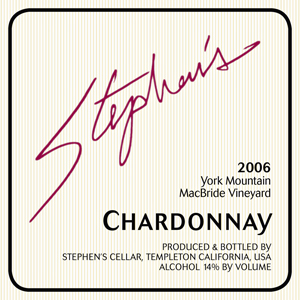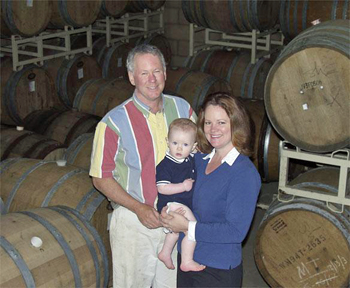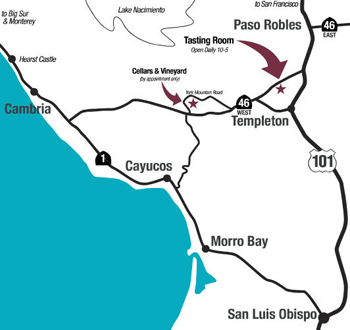

Just west of Paso Robles, Steve Goldman runs Stephen's Cellars winery. While there are few neighboring wineries in the AVA, Steve sees great potential for future growth.
What’s Up on York Mountain?
A Small AVA Adjacent To Paso Robles Shows Great Potential For Pinot Noir.
by
Laurie Daniel
June 27, 2007
Laurie Daniel (LD): The York Mountain AVA butts up against the western edge of the Paso Robles AVA. What are the differences between the two appellations? Is York Mountain significantly different from the westernmost parts of the Paso Robles appellation?
Steve Goldman (SD): The significant differences between the AVAs are climate, soils and size. The climate is derived from its close proximity to the ocean (seven miles), which influences York
A FAMILY AFFAIR: Steve Goldman, along with wife Lori and son Max, stands amidst his York Mountain winery’s barrels.Mountain’s cooler temperatures. The York Mountain AVA has a temperature classification of a Region 1 (approximately 1,900 degree days), whereas the westernmost part of the Paso Robles AVA has a classification of 2 to 3 (with 1 being the coldest and 5 the hottest). Rainfall in the York Mountain area averages about 50 inches a year. The Paso area is about 15-25 inches. The other maritime influence is fog, which cools and moisturizes the air. The York Mountain area generally has fog down to the Jack Creek area. Going west to east, there is less fog.
Soils vary somewhat in the York Mountain area due to its mountainous terrain yet have consistent characteristics. The cultivatable York Mountain soils are shallow sandstone and sandy clay, with a few alluvial deep sandy clay-loam and limestone outcroppings. The Paso area has more diverse soils. The York Mountain soil pH generally runs between 5.2 and 6.8 (acidic). The Paso Robles area has soil pH that is between 6.5 and 7.5 (neutral to alkaline).
LD: How uniform is the terroir within the York Mountain appellation?
SD: The uniformity of the York Mountain area is more consistent due to its size. The York Mountain area is 6,400 acres, or about 10 square miles. The Paso area is much greater with more diversity.
LD: Are there any special challenges involved in farming in the AVA, especially considering the rainfall?
SD: I'm glad you asked about farming on York Mountain. It is difficult. The high amount of rainfall can be very beneficial yet can create certain challenges. Runoff and soil erosion are negative, especially with the mountainous terrain. One must be very careful to preserve the soil and streams. Many guidelines and techniques are used to prevent adverse effects. Cover cropping, water runoff dispersions, limited cultivation and avoiding soil compaction are just a few. Common sense and timing of all cultural procedures are essential. One does not mess with Mother Nature without consequences. Vineyard design and planning with conservation in mind are prerequisites to success.
LD: Is there a signature wine, something that the appellation is particularly well suited for?
SD: Historically, the vineyards were planted mainly to Zinfandel. The variety was difficult to grow consistently due to its general need for higher temperatures and a longer, drier growing season. I did several rootstock and varietal trials between 1975 and 1990 with UC-Davis and the San Luis Obispo farm advisers, and we determined that the varieties best suited to York Mountain are Pinot Noir, Chardonnay, Cabernet Sauvignon, Cabernet Franc, Merlot, White Riesling and Gewurztraminer. Recently, Syrah has been successfully cultivated. There may be other cool-climate varieties that can be grown successfully but aren’t planted at this time.
LD: Are all the varieties you listed still grown in the AVA?
SD: The Riesling and Gewurztraminer were in a test plot but not planted for production. The Merlot has been unfortunately removed. Pinot Noir, Cabernet Sauvignon, Syrah, Chardonnay and Cabernet Franc are commercially grown now. A small, non-commercial backyard Zinfandel plot is planted.
LD: What are the stand-out varieties?
SD: Pinot Noir has to be the stand-out.
LD:: I know that you work with some vineyards, like Encell, that are just outside the appellation. Should the AVA’s boundaries be tweaked?
AVA’s boundaries be tweaked?
SD: Although the Encell, Moore and Cruz vineyards, which border the eastern boundary, and the Stromsoe and Laughney vineyards on the western boundary have characteristics similar to those of the York Mountain AVA, the current boundaries should remain intact. Any extension would diminish the unique character and distinction of the York Mountain AVA.
LD: There aren’t many wineries within the AVA, although I know that there are a few other wineries making York Mountain AVA wines. Are any efforts under way to get the word out about the appellation?
SD: Stephen’s Cellar and Rocky Creek Cellar are the only wineries actually producing wine in the AVA. Shadow Canyon owns a vineyard in the York Mountain area but processes elsewhere. York Mountain Winery has a functioning tasting room, but no production is currently done on location. To my knowledge, two new wineries are planned. Grapes grown in the York Mountain AVA are now being used by Adelaida, Byington, Calcareous and Lone Madrone, which are all outside the area. A few York Mountain AVA promotional meetings have occurred, with little done yet.
Get a taste of Stephen's Cellars. Read our review of the 2004 Chardonnay
Steve Goldman (SD): The significant differences between the AVAs are climate, soils and size. The climate is derived from its close proximity to the ocean (seven miles), which influences York

A FAMILY AFFAIR: Steve Goldman, along with wife Lori and son Max, stands amidst his York Mountain winery’s barrels.
Soils vary somewhat in the York Mountain area due to its mountainous terrain yet have consistent characteristics. The cultivatable York Mountain soils are shallow sandstone and sandy clay, with a few alluvial deep sandy clay-loam and limestone outcroppings. The Paso area has more diverse soils. The York Mountain soil pH generally runs between 5.2 and 6.8 (acidic). The Paso Robles area has soil pH that is between 6.5 and 7.5 (neutral to alkaline).
LD: How uniform is the terroir within the York Mountain appellation?
SD: The uniformity of the York Mountain area is more consistent due to its size. The York Mountain area is 6,400 acres, or about 10 square miles. The Paso area is much greater with more diversity.
LD: Are there any special challenges involved in farming in the AVA, especially considering the rainfall?
SD: I'm glad you asked about farming on York Mountain. It is difficult. The high amount of rainfall can be very beneficial yet can create certain challenges. Runoff and soil erosion are negative, especially with the mountainous terrain. One must be very careful to preserve the soil and streams. Many guidelines and techniques are used to prevent adverse effects. Cover cropping, water runoff dispersions, limited cultivation and avoiding soil compaction are just a few. Common sense and timing of all cultural procedures are essential. One does not mess with Mother Nature without consequences. Vineyard design and planning with conservation in mind are prerequisites to success.
LD: Is there a signature wine, something that the appellation is particularly well suited for?
SD: Historically, the vineyards were planted mainly to Zinfandel. The variety was difficult to grow consistently due to its general need for higher temperatures and a longer, drier growing season. I did several rootstock and varietal trials between 1975 and 1990 with UC-Davis and the San Luis Obispo farm advisers, and we determined that the varieties best suited to York Mountain are Pinot Noir, Chardonnay, Cabernet Sauvignon, Cabernet Franc, Merlot, White Riesling and Gewurztraminer. Recently, Syrah has been successfully cultivated. There may be other cool-climate varieties that can be grown successfully but aren’t planted at this time.
LD: Are all the varieties you listed still grown in the AVA?
SD: The Riesling and Gewurztraminer were in a test plot but not planted for production. The Merlot has been unfortunately removed. Pinot Noir, Cabernet Sauvignon, Syrah, Chardonnay and Cabernet Franc are commercially grown now. A small, non-commercial backyard Zinfandel plot is planted.
LD: What are the stand-out varieties?
SD: Pinot Noir has to be the stand-out.
LD:: I know that you work with some vineyards, like Encell, that are just outside the appellation. Should the
 AVA’s boundaries be tweaked?
AVA’s boundaries be tweaked?
SD: Although the Encell, Moore and Cruz vineyards, which border the eastern boundary, and the Stromsoe and Laughney vineyards on the western boundary have characteristics similar to those of the York Mountain AVA, the current boundaries should remain intact. Any extension would diminish the unique character and distinction of the York Mountain AVA.
LD: There aren’t many wineries within the AVA, although I know that there are a few other wineries making York Mountain AVA wines. Are any efforts under way to get the word out about the appellation?
SD: Stephen’s Cellar and Rocky Creek Cellar are the only wineries actually producing wine in the AVA. Shadow Canyon owns a vineyard in the York Mountain area but processes elsewhere. York Mountain Winery has a functioning tasting room, but no production is currently done on location. To my knowledge, two new wineries are planned. Grapes grown in the York Mountain AVA are now being used by Adelaida, Byington, Calcareous and Lone Madrone, which are all outside the area. A few York Mountain AVA promotional meetings have occurred, with little done yet.
Get a taste of Stephen's Cellars. Read our review of the 2004 Chardonnay










 READER FEEDBACK: To post your comments on this story,
READER FEEDBACK: To post your comments on this story,





